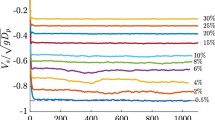Abstract
The entire procedure of hindered sedimentation has been calculated by the introduction of new boundary conditions to the ‘unified theory on solid-liquid separation.’ During this study, the hindered sedimentation was defined as ‘a process of sedimentation with transmission of the gravitational force between the particles due to contact.’ The lower concentration limit, on which the ‘unified theory on solid-liquid separation’ is based, could not be applied. To understand the mechanism of hindered sedimentation, variations in the porosity during sedimentation were calculated by using our theory.
Similar content being viewed by others
References
Alan, S. M. and Justin, C. B., “Settling Rates and Sedimentation Volumes of Flocculated Kaolin Suspensions,”I. & E.C. Fundamentals,1, 25 (1962).
Burger, R., Concha, F. and Tiller, F. M., “Applications of the Phenomenological Theory to Several Published Experimental Cases of Sedimentation Processes,”Chemical Engineering Journal,80, 105 (2000).
Grace, H. P., “Resistance and Compressibility of Filter Cakes. Part I,”Chemical Engineering Progress,49, 303 (1953).
Kynch, G. J., “A Theory of Sedimentation,”Trans. Faraday Assoc.,48, 166 (1952).
Maude, A. D. and Whitmore, R. L., “A Generalized Theory of Sedimentation,”J. Appl. Phs. (Br.),9, 477 (1958).
McCabe, W. L., Smith, J. C. and Harriott, P.,Unit Operations of Chemical Engineering, 5th ed., McGraw-Hill Book Co., New York, NY (1995).
Richardson, J. F. and Zaki, W. N., “Sedimentation and Fluidization: Part I,”Trans. Inst. Chem. Engrs.,32, 32 (1954).
Ruth, B. F., “Correlating Filtration Theory with Industrial Practice,”Industrial and Engineering Chemistry,38, 564 (1946).
Tiller, F. M. and Cooper, H., “The Role of Porosity in Filtration: Part V. Porosity Variation in Filter Cakes,”AIChE J.,8, 445 (1962).
Tiller, F.M. and Crump, J.R., “Solid-Liquid Separation : An Overview,”CEP, 65 (1977).
Tiller, F.M. and Horng, L. L., “Hydraulic Deliquoring of Compressible Filter Cakes,”AIChE J.,29, 297 (1983).
Tiller, F. M. and Khatib, Z., “The Theory of Sediment Volumes of Compressible, Particulate Structures,”Journal of Colloid and Interface Science,100, 55 (1984).
Yim, S. S. and Kwon, Y. D., “A Unified Theory on Solid-Liquid Separation: Filtration, Expression, Sedimentation, Filtration by Centrifugal Force, and Cross Flow Filtration,”Korean J. Chem. Eng.,14, 354 (1997).
Yim, S. S., Song, Y.M. and Kwon, Y. D., “The Role of Pi, Pa, and Pf in Constitutive Equation, and Boundary Condition in Cake Filtration,”Korean J. Chem. Eng.,20, 334 (2003).
Yim, S. S., Song, Y. M. and Lee, J.Y., “New Expression Theory Based on Darcy’s Equation: Unified Theory on Solid-Liquid Separation,”Korean Chem. Eng. Res.,41, 471 (2003).
Author information
Authors and Affiliations
Corresponding author
Rights and permissions
About this article
Cite this article
Yim, SS., Song, YM. Study on the mechanism of hindered sedimentation by ‘unified theory on solid-liquid separation’. Korean J. Chem. Eng. 22, 433–440 (2005). https://doi.org/10.1007/BF02719423
Received:
Accepted:
Issue Date:
DOI: https://doi.org/10.1007/BF02719423




